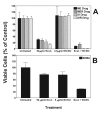Anticancer activity of extracts derived from the mature roots of Scutellaria baicalensis on human malignant brain tumor cells
- PMID: 16914050
- PMCID: PMC1560162
- DOI: 10.1186/1472-6882-6-27
Anticancer activity of extracts derived from the mature roots of Scutellaria baicalensis on human malignant brain tumor cells
Abstract
Background: Flavonoid-rich extracts from the mature roots of Scutellaria baicalensis have been shown to exhibit antiproliferative effects on various cancer cell lines. We assessed the ability of an ethanolic extract of S. baicalensis root to inhibit the proliferation of malignant glioma cells.
Methods: Cell lines derived from primary and recurrent brain tumors from the same patient and cells selected for resistance to the chemotherapeutic agent 1,3-bis(2-chloroethyl)-1-nitrosourea (BCNU) were used to identify antiproliferative effects of this extract when used alone and in conjunction with BCNU.
Results and discussion: Results indicated that Scutellaria baicalensis not only inhibits cellular growth in recurrent and drug resistant brain tumor cell lines, but also demonstrates an increased inhibitory effect when used in conjunction with BCNU.
Conclusion: The results of this study support the efficacy of S. baicalensis as an anticancer agent for glioblastomas multiforme and a potential adjuvant treatment to current chemotherapeutic agents used in the treatment of both primary and recurrent GBMs. Further studies of the effects of individual flavonoids alone and in combination with each other and with currently used therapies are needed.
Figures






References
-
- American Cancer Society . Cancer Facts and Figures 2006. Atlanta, American Cancer Society; 2006.
-
- Scheck AC, Shapiro JR, Coons SW, Norman SA, Johnson PC. Biological and molecular analysis of a low grade recurrence of a glioblastoma multiforme. Clin Cancer Res. 1996;2:187–199. - PubMed
-
- Seigler DS. Plant Secondary Metabolism. Boston: Kluwer Academic; 1998.
-
- Harborne JB. Arsenal for survival: secondary plant products. Taxon. 2000;49:435–449. doi: 10.2307/1224343. - DOI
Publication types
MeSH terms
Substances
LinkOut - more resources
Full Text Sources
Other Literature Sources
Medical
Miscellaneous

